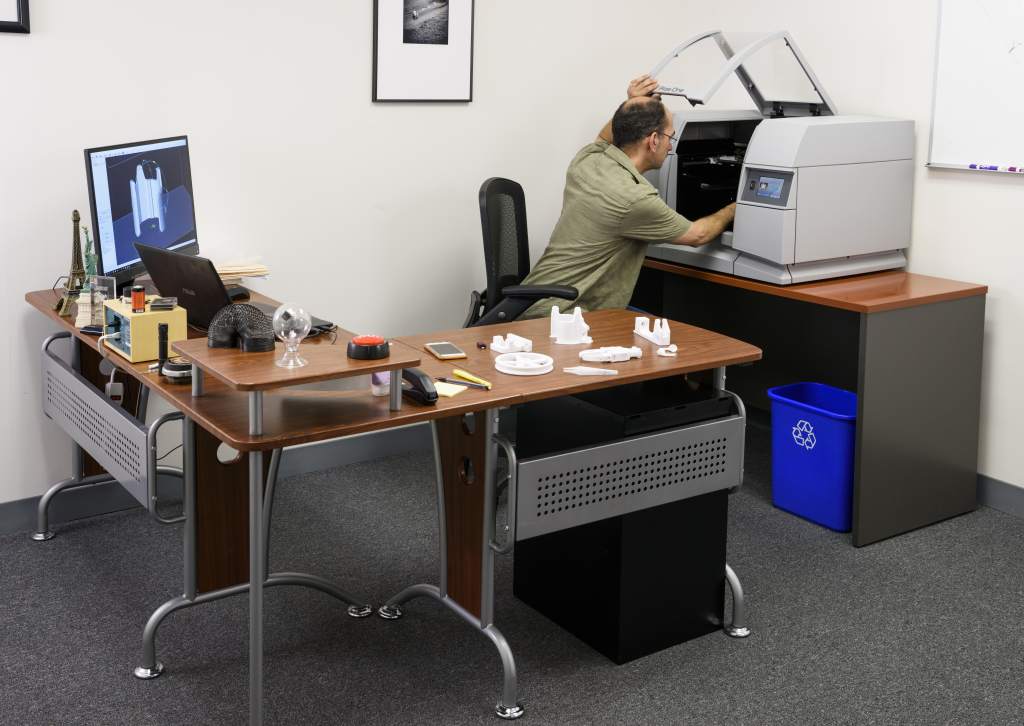This is a guest post in our series looking at the future of 3D Printing.
To celebrate 5 years of reporting on the 3D printing industry, we’ve invited industry leaders and 3D printing experts to give us their perspective on the next 5 years of 3D printing.
Frank Marangell is the CEO and President of Rize, the innovative 3D printing company behind the patented Augmented Polymer Deposition method.
McKinsey Global Institute reports that of the $12 trillion manufacturing industry, $800 billion per year by 2025 will be direct manufacturing and tooling. And, of that, 50% ($230 billion to $550 billion per year) will be 3D printed.
Despite this colossal market opportunity, most of today’s industrial-class 3D printers are only suitable for prototyping and tooling and must operate in additive manufacturing labs due to their size, expense, special facility and equipment requirements and complex pre- and post-processing methods.

3D printing’s Holy Grail
Currently, only a few systems, Carbon, HP and some metal 3D printers, are capable of addressing the market for low-to mid-volume manufacturing parts. Although these companies are legitimizing 3D printing for manufacturing, their systems come with significant limitations that restrict the large-scale adoption of, and applications for, 3D printers in direct manufacturing. The industry’s Holy Grail over the next few years will be the ability to 3D print injection-molded-quality parts on demand, quickly, safely and affordably.
To achieve this goal and significantly expand manufacturing applications and markets for 3D printing, industrial 3D printing technology must break the chains of the additive manufacturing lab and move into the office, wherever that ‘office’ is located and whatever form it takes. There’s an enormous, unaddressed market for producing customized one-offs and low-volume manufactured end-use parts and tooling on demand, in both lab and non-lab environments, including the mechanical engineer’s office to make real functional parts; on the manufacturing floor next to the assembly line to make custom tools, jigs and fixtures on the fly; in the factory to make spare part replacements on demand rather vs. in bulk years earlier and stored; in the dental, medical and audiology office to produce dental devices, surgical guides and hearing aids uniquely tailored for each patient; the mechanic shop to make replacement parts; on ships, in air, on spacecraft and in military field locations for field repairs and more.

The Manufacturing Office concept
The concept of The Manufacturing Office is a new paradigm in manufacturing because existing manufacturing-capable 3D printing systems are unable to address this market. It is simply inefficient and impractical for them to produce one-offs, given their size, price and complexity and they certainly aren’t systems that can be located in the office or in other remote, non-lab locations due to their materials, processes and post-processing requirements.
Prototyping-capable 3D printers, representing the majority of industrial-class 3D printers today, cannot produce parts with the required strength, surface finish, heat deflection temperature (HDT), color, and other properties that would be considered acceptable for injection molded-quality parts. Further, these systems involve steps throughout their processes that cannot be done in an office and in remote locations outside of a specially-equipped additive manufacturing lab.
With the burst of the consumer and hobbyist 3D printing bubble over the last couple of years, some companies that previously offered a low-cost line of desktop 3D printers for this audience are marketing their hobby-class desktop 3D printers as low-cost, commercial-grade systems. However, these machines are not suitable for manufacturing and other industrial use either in the office or the lab due to insufficient part strength and material properties, messy and time-consuming post-processing methods, substandard part quality, printer reliability and durability concerns, inadequate build volume and harmful particle emissions, among other factors.
Growing commercial 3D printing adoption
To address the untapped Manufacturing Office market and, in doing so, grow commercial 3D printing adoption and applications, the industry will demand an industrial 3D printing technology suitable for the office or additive manufacturing lab, that can vary material properties at the voxel (3D pixel) level to produce injection molded-quality parts with required isotropic strength, surface finish, HDT, detailed color and more, while offering a completely safe, clean and easy process from file to finished part, without any post-processing or toxic emissions and with safe, Green, biocompatible materials. These factors, in addition to an affordable purchase and ongoing operational cost, will permit efficient, low-cost production of customized one-off and low-volume tools, spare parts and end-use products on the fly by the people who use them.

Such versatile technology will be an ideal complement to manufacturing-capable machines operating in labs building low- to mid-volumes of end-use parts. In fact, over-burdened additive manufacturing lab managers would not only be happy to use this technology in their labs, they would also like to place them in their engineers’ offices to reduce their own workload and put parts directly and immediately into the hands of the people who need them.
For more information about Rize, follow this link.
This is a guest post in our series looking at the future of 3D Printing, if you’d like to participate in this series then contact us for more information. For more insights into the 3D printing industry, sign up to our newsletter and follow our active social media channels.
Don’t forget that you can vote now in the 1st annual 3D Printing Industry Awards.



